Bivråkens Pernis apivorus boplatsval
DOI:
https://doi.org/10.34080/os.v4.23016Nyckelord:
val av boplats, habitatval, habitatkvalitet, skogskvalitetAbstract
At 30 Honey Buzzard nests in southwest Uppland (59°45'N) data were collected concerning different parameters of the forest (tree species composition, age, density, site quality class, silviculture, history etc.). These data were compared with the same parameters collected from a random sample of 32 spots in forests from the same area. The results show that the Honey Buzzard Pernis apivorus preferred to nest in diversified forest with high site quality class, and the preferred forests were often neglected concerning forestry measures and were also often affected by earlier wood pasturage. Old forests with a high proportion of deciduous trees and with a high mixture of tree species were preferred, while no nests were found in pine forest despite this forest type being the most common in the study area. The nests of Honey Buzzard were not randomly situated in the landscape but tended to be congregated along lakes, where also the highest site quality class forests were found.
Nedladdningar

Downloads
Publicerad
Referera så här
Nummer
Sektion
Licens
Författaren/författarna innehar copyright för varje enskilt bidrag, men samtliga bidrag är publicerade under en Creative Commons-licens, så att vem som helst kan dela och återanvända bidraget förutsatt att copyright-innehavaren erkänns.







